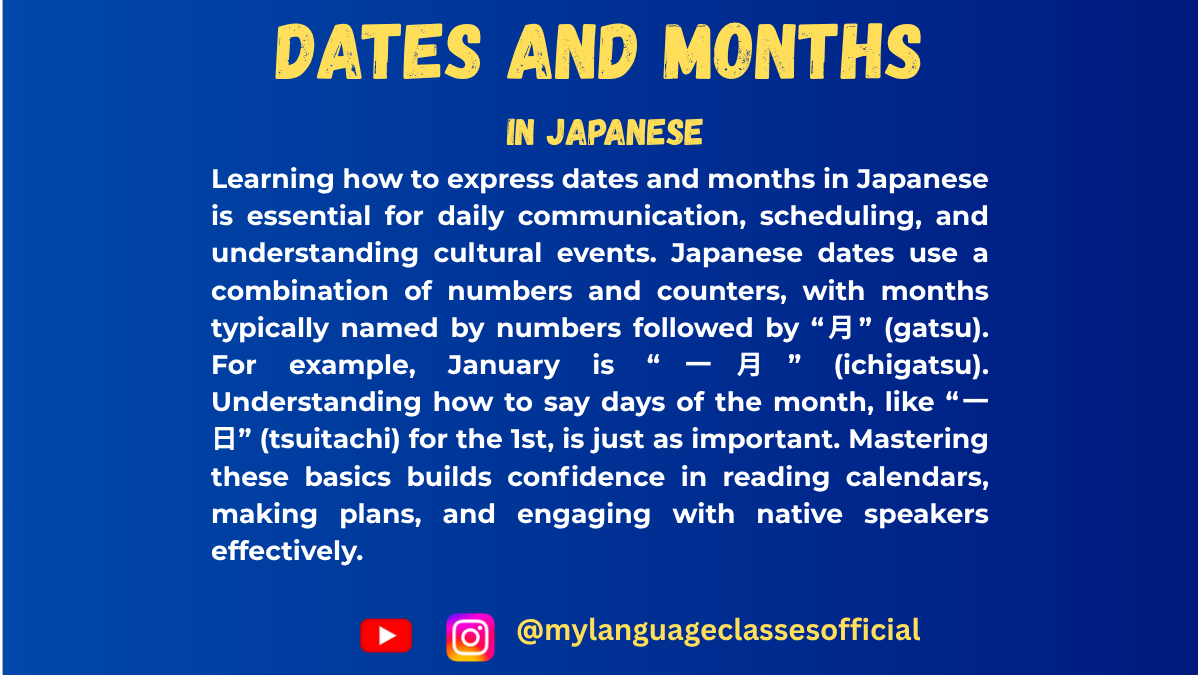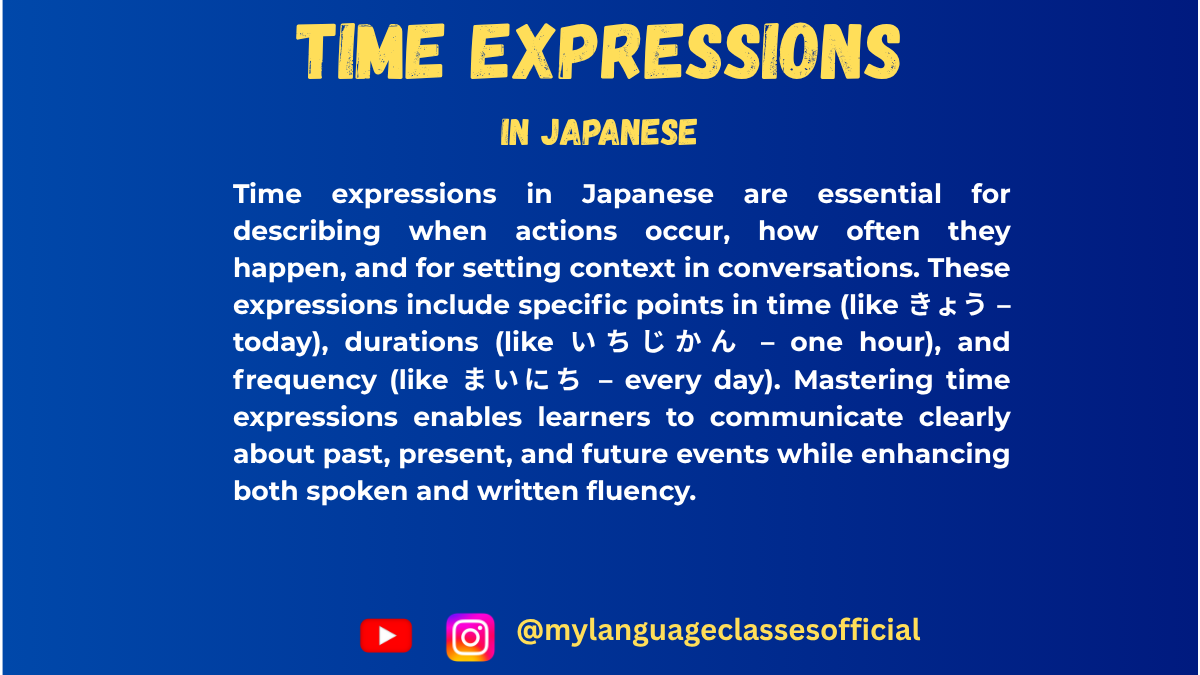Your cart is currently empty!
Tag: how to say dates in Japanese
-

Mastering Dates and Months in Japanese | My Language Classes
Dates and Months in Japanese
こんにちは (Konnichiwa)!
If you’re learning Japanese, one of the essential skills is telling the date. Japanese has unique ways to express dates that differ from English or many other languages. In this post, we’ll cover everything you need to know about telling dates in Japanese, including a handy list of how to say specific dates and some cultural and linguistic nuances to keep in mind. Let’s dive in!
Understanding Japanese Dates: Basic Structure
In Japanese, the date format is typically written as Year-Month-Day (e.g., 2024年12月25日, 2024-12-25). The characters used are:
- 年 (nen) for “year”
- 月 (gatsu) for “month”
- 日 (nichi) for “day”
For example:
- 2024年12月25日 = “2024 December 25”
- Read as: にせんにじゅうよねん じゅうにがつ にじゅうごにち (Nisen-nijūyo-nen, jūni-gatsu, nijūgo-nichi)
Days of the Month in Japanese
Japanese has specific terms for the first 10 days and certain other days of the month. Here’s a list of the most common:
1st to 10th and 20th (Special Readings):
- 1日 (ついたち) – Tsuitachi
- 2日 (ふつか) – Futsuka
- 3日 (みっか) – Mikka
- 4日 (よっか) – Yokka
- 5日 (いつか) – Itsuka
- 6日 (むいか) – Muika
- 7日 (なのか) – Nanoka
- 8日 (ようか) – Yōka
- 9日 (ここのか) – Kokonoka
- 10日 (とおか) – Tōka
- 20日 (はつか) – Hatsuka
Days After the 10th:
For days after the 10th (except 20th), simply use the number + 日 (にち, nichi). For example:
- 11th = 11日 (じゅういちにち) – Jūichi-nichi
- 12th = 12日 (じゅうににち) – Jūni-nichi
- 13th = 13日 (じゅうさんにち) – Jūsan-nichi
Continue this pattern up to the 31st:
- 21st = 21日 (にじゅういちにち) – Nijūichi-nichi
- 30th = 30日 (さんじゅうにち) – Sanjū-nichi
- 31st = 31日 (さんじゅういちにち) – Sanjūichi-nichi
Months in Japanese
Months in Japanese are much simpler. They are numbered from 1 to 12 followed by 月 (gatsu). For example:
- January = 1月 (いちがつ) – Ichigatsu
- February = 2月 (にがつ) – Nigatsu
- March = 3月 (さんがつ) – Sangatsu …and so on.
Key Grammar and Usage Notes
1. No Articles:
Unlike English, Japanese does not use articles like “the” or “a.” So, you simply state the date without worrying about additional words.
2. No Plural Forms:
Japanese nouns do not have plural forms. For example, the word 日 (nichi) stays the same whether you’re talking about one day or many days.
3. Gender-neutral Language:
Japanese does not have gender-specific nouns or articles. The way you say dates remains the same regardless of who is speaking or listening.
4. Pronunciation Challenges:
- Pay special attention to the unique readings for the 1st to 10th and the 20th.
- Be careful with long vowels, such as in ようか (8th), where the “ou” sound must be elongated.
5. Cultural Context:
When writing or saying the date in Japanese, it’s common to follow the year-month-day structure. If you’re addressing someone formally, especially in written communication, add です (desu) or でございます (de gozaimasu) for politeness.
Practice Makes Perfect!
Here’s an example of a complete date in Japanese:
- Today is December 25, 2024
→ 2024年12月25日です
→ にせんにじゅうよねん じゅうにがつ にじゅうごにち です
Pro Tips for Fluency
- Memorize the unique readings for the 1st to 10th and 20th – These are the most irregular and require rote learning.
- Practice with real dates – Try saying your birthday, important holidays, or even today’s date.
- Listen to native speakers – Watch Japanese TV shows, listen to podcasts, or use language apps to hear how dates are pronounced naturally.
Now that you’ve mastered dates in Japanese, try using them in conversation! Whether you’re booking an appointment or celebrating a special occasion, understanding how to express dates will bring you one step closer to fluency.
If you enjoyed this lesson, be sure to check out more posts like this on my blog at My Language Classes. Don’t forget to subscribe my YouTube channel and follow me on Instagram for the latest language learning tips and lessons. Leave a comment below to share your thoughts, or ask any questions you have about nouns.
Happy learning! 😊

